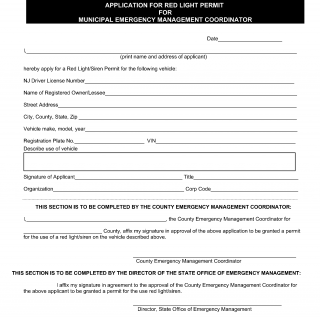Form BLC-50. Red Light Permit application- Municipal OEM Coord
The BLC-50 Red Light Permit application is a form that needs to be filled out by individuals or organizations who wish to obtain a permit for installing a red light on their property within the jurisdiction of the Municipal OEM Coord in New Jersey. The primary purpose of this form is to ensure public safety by regulating the installation and operation of red lights on private properties.
The form consists of several parts, including personal information of the applicant, location details of the proposed installation, and technical specifications of the red light equipment. The important fields that need to be filled in include the applicant's name, address, contact number, and email address, along with the exact location of the proposed installation and the type of red light equipment that will be used.
The parties involved in the process include the applicant, who will fill out the form, and the Municipal OEM Coord in New Jersey, which will review and approve or deny the application based on compliance with applicable regulations and standards. It is important to consider compliance with all relevant regulations and standards when filling out the form.
Additional data that may be required when filling out the form includes information about any existing structures near the proposed installation site and any existing permits related to the property. The applicant may also need to attach additional documents, such as a map of the proposed installation site or technical specifications of the red light equipment.
An example of an application for this form could be a business owner who wants to install a red light on their property to prevent accidents or enhance security. The practice and use cases for this form primarily involve ensuring public safety and regulating the installation of red lights on private properties.
Strengths of this form include its ability to regulate the installation and operation of red lights on private properties, thereby enhancing public safety. However, weaknesses may include potential delays in the approval process due to the need for review by the Municipal OEM Coord in New Jersey. Opportunities may include the ability to update the form with new regulations and standards to further improve public safety, while threats may include non-compliance with applicable regulations and standards.
An alternative form or analogue for this form could be a permit application for installing traffic signs on private properties. The main difference between the two forms is the type of equipment being installed, but both forms serve the purpose of regulating the installation of equipment on private properties to enhance public safety.
The future of the participants in the process will be impacted by the approval or denial of the permit application. If approved, the applicant will be able to install the red light on their property, while if denied, they will need to modify their application to comply with applicable regulations and standards or forego the installation altogether.
The completed form can be submitted to the Municipal OEM Coord in New Jersey either electronically or in person at their office. The form will be stored by the Municipal OEM Coord for record-keeping purposes and may be subject to public disclosure under applicable laws.

